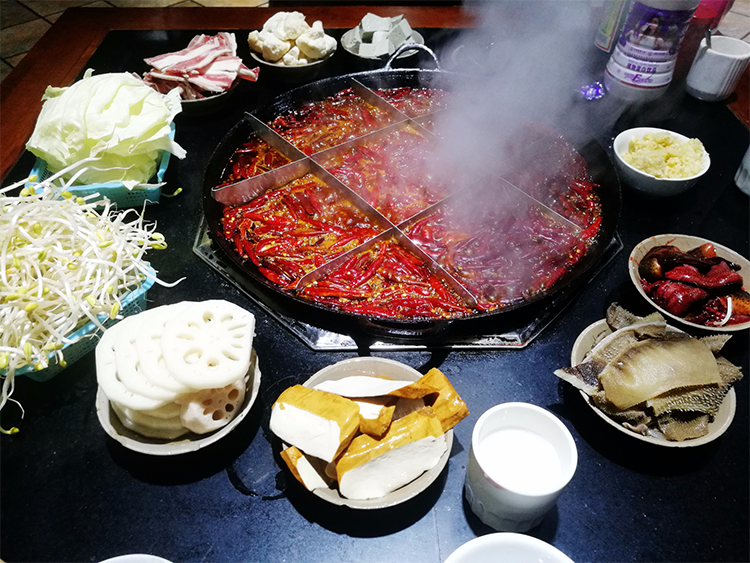Sichuan Spicy Hot Pot: A Flavorful Guide
Sichuan Spicy Hot Pot: A Flavorful Guide
Imagine a bubbling pot of red oil and chilies filling the air with an intense aroma. Friends gather around the table, dipping fresh tripe, beef slices, and vegetables into the boiling broth, then into a sesame-and-garlic dipping sauce. The result: a thrilling blend of numbness, heat, fragrance, and freshness. Sichuan and Chongqing Spicy Hot Pot is not only a global culinary sensation but also a vivid way to experience the warm, communal culture of southwest China.
1. Origins: From River Dock Workers to the World
The earliest forms of spicy hot pot emerged along the Yangtze River during the Ming and Qing dynasties. Boatmen and laborers used inexpensive offal and other affordable ingredients, cooking them in intensely spiced broths to stay warm and nourished. This practical meal evolved into neighborhood stalls and, by the 1920s, dedicated Chongqing Tripe Hot Pot restaurants, setting the foundation for modern hot pot. Since China’s reform era, Sichuan and Chongqing Hot Pot has spread across the country and internationally, becoming a signature of Chinese culinary culture.
2. Cultural Meaning: A Chinese Social Ritual
Eating hot pot in Sichuan and Chongqing goes beyond sustenance. The round pot symbolizes reunion and harmony, while sharing a pot emphasizes community and reciprocity. The lively, steam-filled atmosphere breaks down social barriers and encourages conversation—perfect for family reunions, friends’ gatherings, or casual business meals. Participating in the cooking process creates a relaxed, interactive dining experience that reflects the region’s open, exuberant spirit.

3. Ingredients and Flavors: Bold, Layered, and Inclusive
The soul of hot pot is the broth. Authentic Sichuan and Chongqing broths rely on dried chilies for pure heat and Sichuan peppercorns for the signature numbing sensation. Traditional broths use beef tallow to carry and deepen the flavors, producing a rich, silky mouthfeel; lighter versions use vegetable oil for a cleaner taste. Many restaurants offer a yuan-yang (half-and-half) pot that splits spicy and mild broths for different preferences.
Typical ingredients include:
- Meats: thinly sliced beef and lamb, tripe, beef throat (huanghou), duck intestine, and other specialty cuts.
- Seafood: shrimp paste, fish fillets, small freshwater fish, and squid.
- Vegetables and tofu: chrysanthemum greens, potato slices, enoki mushrooms, tofu, and bean curd skin.
- Snacks and sides: sweet rice cakes and crispy pork pieces often accompany the meal.
Briefly cooked, ingredients retain freshness while soaking up the spicy, numbing broth—yielding a complex fivefold taste of numb, hot, fresh, fragrant, and tactile heat that keeps diners coming back.
4. How It’s Made and Eaten: A Participatory Ceremony
Broth bases are typically prepared by chefs using house recipes: doubanjiang (broad-bean chili paste), fermented black beans, aromatics, spices, and a generous amount of chilies and Sichuan peppercorns, often fried in beef tallow until deeply fragrant. The base is then combined with stock and brought to a boil before being placed at the table.
Diners select ingredients and control cooking times. Tripe and duck intestine are cooked briefly to preserve crunch; thin beef is swished until it just changes color; heartier items like potatoes take longer. Each person usually has a personal dipping sauce—classic is sesame oil mixed with crushed garlic, with optional additions like cilantro, scallions, or oyster sauce. The oil-based dip cools food, balances heat, and enhances aroma, making it essential to the experience.
5. Tips for Tourists: What to Order and Practical Advice
- Choose the broth: If you can’t tolerate heat, order a yuan-yang pot and start with the mild side. Ask for “mild” or “light spice” if needed. Keep a cold drink ready to ease the burn.
- Must-try items: tripe, beef throat (huanghou), and duck intestine showcase authentic Sichuan-Chongqing Hot Pot textures and flavors—don’t hesitate to try them.
- Don’t skip the dipping sauce: sesame-garlic oil dip balances spice and enhances taste.
- Drink pairings: ice-cold soy milk, chilled herbal tea, or a cold beer are traditional pairings that soothe the palate.
- Popular chains: international travelers often choose Haidilao, Xiao Long Kan, and DeZhuang for consistent hygiene and quality.
- Reservations: hot pot restaurants fill up quickly at peak hours. Reserve ahead or visit during off-peak times.

6. Simple Home Version for Travelers
If you want to recreate the experience at home:
- Buy a pre-made hot pot base from an Asian supermarket.
- Simmer the base in water or stock until boiling.
- Prepare favorite ingredients: thin beef slices, shrimp, mushrooms, greens, and tofu.
- Make a quick dipping sauce: crushed garlic with sesame oil and oyster sauce, plus chopped cilantro if desired.
- Keep the broth simmering on a portable cooker and enjoy a shared, interactive meal with friends.


